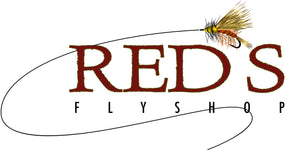Cold water typically means sluggish trout, but it doesn't have to mean sluggish fishing. Many mature trout will eat aggressively if the presention is right. The same aggressive jiggy style tactics used in warm water simply won't work in cold water. To be successful you will want to be steady, smooth, slow and low. Trout are often in bigger holes, wider runs, and prefer to ambush slow moving prey they have identified well in advance.
"You must get your fly to move slower and lower to have success with trout spey tackle during the winter months."
PodCast on Cold Water Tactics - Trout Spey and Euro Nymphing
How to Catch Fish in Cold Water With Trout Spey Rods
The first tip is to understand that winter fish are typically "holed up" for winter and will most often be in the predictable holes or runs with extended depth. This gives the trout more access to insulation from the earth, and often they will seek out aquifers that exist in the deeper pools. This slightly warmer water is attractive to the trout. As the air becomes warmer than the water in the afternoon, shallower water will become warmer and can attract the fish up onto the ledges in the afternoon. Look for this trend on warm nights as well. Some of my best days of streamer fishing have been when we have a warm day, then clouds blow in at night and the ambient temperature remains warm (in the upper 30's to low 40's all night). Since you don't get that cold night typically associated with clear skies, the water temp comes up a notch and the fish take advantage! If you see this coming in the forecast try to take advantage.
The OPST Groove Shooting Head or Intermediate Skagit Heads
If the goal is to present your fly "slower and lower" for winter trout then an Intermediate sinking head is VERY helpful. The surface currents of a river are fast. The deeper currents are slower. If you can get your shooting head down under the swiftest currents the result is a slower and more controlled presentation. The velocity at which your fly moves over the fish is less, and in my experience this generates more strikes.
Ultimatley, you will probably get deeper using a Skagit Intermediate or sinking head like the Groove but that isn't the entire goal. If you simply wanted deeper, a heavy fly would probably do it. Our goal is a smooth, slow, and deep presentation that moves with ease and generates strikes. Floating heads and weighted flies can't quite replicate that action. It just isn't the same. If you are a dedicated trout spey angler, give this product a shot. Fish it behind your buddies and you'll see the difference!
What Grain Weight Should I Buy?
If you already have an established setup and like it, buy a Groove head that is 25 grains lighter. Being a sinking head it will stick to the water during your D Loop with more adhesiveness.

